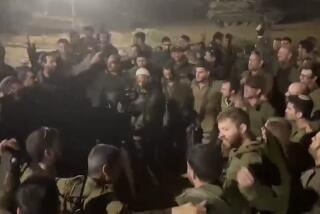Islamic State’s media-savvy militants spread message with ease
Reporting from Washington — Driving hulking tanks and armored trucks, Islamic State militants conducted a victory parade of sorts recently in Raqqah, their stronghold in northern Syria, flaunting military hardware that they had captured.
Some of the masked fighters muscled the massive tanks into tight circles, spinning them around and around in front of a cheering crowd.
The startling imagery, posted on YouTube in June, not only raced across social media. It was picked up by CNN and other TV networks, boosting the global profile of Islamic State as it seeks to establish and violently expand its rule across much of the Middle East.
Before he was killed in 2011, Al Qaeda founder Osama bin Laden attempted to recruit and rally followers with sermons that now seem as dated as black-and-white TV. His aides had to secretly hand deliver videotapes to Al Jazeera TV to get his words out.
Today, media-savvy militants in Iraq and Syria post graphic photos and slick recruitment videos on Facebook and Twitter, and even developed a now-defunct Android smartphone app that would automatically tweet from users’ accounts. Fighters in the field answer questions from supporters on websites and chat rooms that allow users to remain anonymous.
“Back in the old days, jihadists would be depicted in recruiting photos with a rifle or a bomb,” said Steven Stalinsky, executive director of the Middle East Media Research Institute, a nonprofit group based in Washington. “Now the laptop and hand-held device are just as important.”
The sentiment is crystallized in a photo circulated on Twitter by pro-Islamic State users that shows three rifle bullets, each with a different top.
“A bullet. A pen. A thumb drive,” the message reads. “There is a different form of jihad.”
Not surprisingly, the CIA is monitoring the Islamic State’s use of social media, according to a spokesman.
“There are concerns about how the group is using these platforms for recruiting purposes to include targeting disenchanted Western youth,” he said.
But social media also provide Western law enforcement and intelligence agencies with digital tools to help fight the group. Photos show captured weapons, provide tips about the location of training camps and massacre sites, and often make it easier to identify individuals, including Americans and other foreign fighters.
On Friday, the government of Britain warned that a terrorist attack is “highly likely” there because of the conflict in Syria and Iraq, and the hundreds of British and European citizens who have joined Islamic State and other militant groups.
In a statement, British Prime Minister David Cameron said Islamic State uses “the most brutal forms of terrorism to force people to accept a warped world view and to live in an almost medieval state, a state in which its own citizens would suffer unimaginable brutality, including barbaric beheadings of those who refuse to convert to their warped version of Islam, the enslavement and raping of women, and the widespread slaughter of Muslims by fellow Muslims.”
Analysts say Islamic State’s propaganda campaign far exceeds that of Al Qaeda or any other recent U.S. adversary in its ability to recruit, raise money and instill fear in enemies.
The high-definition video of a masked militant beheading American journalist James Foley horrified many when it was posted on YouTube on Aug. 19.
Several days later, another Islamic State video showed armed militants herding more than 150 men, each stripped to his underwear, down a desert track. The men, reportedly Syrian soldiers captured at Tabqa air base, then apparently were shot; the video shows an extended line of nearly naked corpses facedown in the sand. Other pictures showed piles of mutilated bodies.
A day later, another video showed the beheading of a captured Kurdish Iraqi fighter. On Friday, another decapitation video appeared, this one reportedly of a Lebanese soldier.
Not all the imagery goes for shock value. Some fighters post selfies or group shots of smiling fighters taking joy rides in captured U.S.-made Humvees. And some even extol their creature comforts.
“Internet, Restaurants, Cars, iPhones ... Allah has made Hijra [emigration] and Jihad in [Syria] so easy ... why are we still … hesitating?” Abu Turab Al-Muhajir, a 25-year-old Chicago man who claimed to have joined the Islamic State, tweeted in December.
The group developed an app called “The Dawn of Glad Tidings” for Android smartphones in April that provided users with news of its grisly exploits, and would automatically tweet from users’ accounts. The app has since been taken down.
Some foreigners muse online about how life at war compares with violent video games or gangster rap music. One British fighter posted a photo of five Syrian children flashing three fingers in a sideways W, like a West Coast rapper.
The importance of the outreach was clear in a yearlong study of the social media profiles of 190 Western foreign fighters by the International Center for the Study of Radicalization and Political Violence at King’s College London.
“For them, social media has come to represent both an essential source of information and inspiration,” the report said. “It is clear to us that in the minds of foreign fighters social media is not merely virtual: It has become an essential part of what happens on the ground.”
More to Read
Sign up for Essential California
The most important California stories and recommendations in your inbox every morning.
You may occasionally receive promotional content from the Los Angeles Times.











